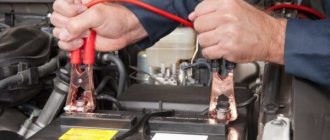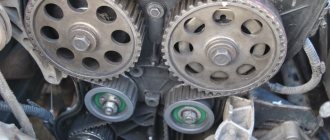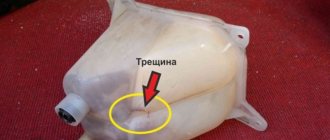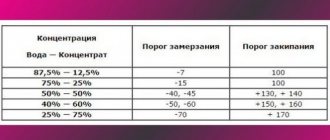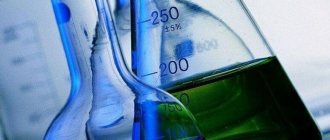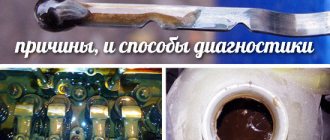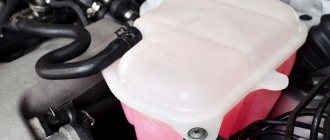The operation of heat engines requires timely removal of excess heat. Internal combustion engines (ICE) with a liquid cooling system have a complex system that ensures the movement of liquid coolant from heat sources to open heat exchangers (radiator and interior heater).
Ordinary water was used for quite a long period, but with the advent of the Zhiguli era (1970), domestic car enthusiasts became acquainted with antifreeze and other types of coolants (coolants) capable of ensuring uninterrupted operation in a wide range of ambient temperatures.
In 1971, the production of antifreeze began, the most common type of antifreeze in the USSR. It was created according to an analogue proposed in Italy. The brand got its name from its developer - the Laboratory of Organic Synthesis Technology. Along the way, it was indicated that it belonged to alcohols, the combination OL at the end of the name of the liquid for cooling engines.
What does antifreeze contain?
When developing antifreeze, we used the recommendations of Italian developers, and even acquired a license for the production of coolants. But the very first tests showed that the Italian recipe does not work in Russian conditions. Even in the Central region, frosts down to -40...-43 ⁰С are possible, and the imported coolant was designed for -25 ⁰С. Therefore, composition adjustments were required.
The main component is ethylene glycol (C₂H₄(OH)₂). This is a high-boiling alcohol, the share of which in antifreeze can range from 40 to 65%. The second component of the coolant for cars is distilled water.
Attention! The use of water from open sources is not recommended. The content of magnesium and calcium salts can be quite significant. Salt deposits will be observed in the engine cooling jacket.
With regular use of ordinary liquid, the thickness of the scale layer can reach several millimeters. Heat transfer will be disrupted to such an extent that the performance of the cooling system will be extremely low.
When creating antifreeze, we noticed that the mechanical mixture of the main liquids is quite aggressive towards some types of plastics and rubber. C₂H₄(OH)₂ dissolves certain types of plastics and also reacts with sulfur used in the vulcanization process of natural rubber. Therefore, detergent additives were added to the composition. Their number is less than 1%. Practice has proven that even a minimal amount of such substances prevents contact between polymers and alcohols.
Another disadvantage of the usual mixture of water and ethylene glycol is the formation of foam when circulated intensively. Anti-foam additives began to be added to antifreeze in 1979 after motorists had complaints about the operation of the cooling system: foam began to release from the expansion tank of cars operated in the summer. This is the result of the interaction of alcohol (C₂H₄(OH)₂) with aluminum alloys.
Coolant under the brand “Tosol A40M” is produced at several enterprises in Russia and neighboring countries. The composition has not changed for 40 years.
Procedure for diluting antifreeze with water
Antifreeze is diluted with water in different ways, depending on the situation and the product purchased.
By car
To mix the liquids in question directly on the vehicle, you will first need to determine the freezing point of the antifreeze using a hydrometer. With its help, we collect some of the liquid from the expansion tank. We compare the device readings with the temperature on the antifreeze canister. If there is no container at hand, then you should focus on the average freezing temperature of the substance -40C. Therefore, water should be added until the indicator reaches the desired value.
To determine the freezing point of antifreeze you will need a hydrometer
In containers
Automotive stores offer antifreeze in two versions:
- ready for use;
- in the form of a concentrate.
If everything is simple with the ready-made product - you bought it and poured it in, then with the concentrate you will have to tinker a little. To dilute it you will need a distillate and a suitable container. The volume of the diluted substance must correspond to the volume of heat removal fluid in your car’s system.
Antifreeze for other heat exchange systems
In addition to automotive applications, coolants for heating systems are produced under the TOSOL brand. The liquid fills pipes, boilers and radiators in individual houses.
The use of non-freezing solutions for heating devices makes it possible to heat houses in summer cottages, where the temperature inside the building can drop below zero. When the owners arrive in winter, they put the heating boiler into operation. The liquid begins intensive circulation through the pipelines, warms up the heating devices and creates comfortable conditions for people to stay in the room.
The same laboratory that created Antifreeze for cars developed a lubricating coolant (coolant) based on ethylene glycol. It is used for metal cutting.
Since 1980, emulsions have been sold, which must be diluted with water when poured into the machine. Subsequently, the parts are processed on machines in machine shops of factories.
Liquids are also used to harden parts; they are based on a composition similar to conventional coolant for cars.
Video.
The operation of heat engines requires timely removal of excess heat. Internal combustion engines (ICE) with a liquid cooling system have a complex system that ensures the movement of liquid coolant from heat sources to open heat exchangers (radiator and interior heater).
Ordinary water was used for quite a long period, but with the advent of the Zhiguli era (1970), domestic car enthusiasts became acquainted with antifreeze and other types of coolants (coolants) capable of ensuring uninterrupted operation in a wide range of ambient temperatures.
In 1971, the production of antifreeze began, the most common type of antifreeze in the USSR. It was created according to an analogue proposed in Italy. The brand got its name from its developer - the Laboratory of Organic Synthesis Technology. Along the way, it was indicated that it belonged to alcohols, the combination OL at the end of the name of the liquid for cooling engines.
The influence of water on the characteristics of antifreeze
The standard version of antifreeze contains from 30 to 65% ethylene glycol. To make it easier for car enthusiasts to navigate, different types of coolant are painted in different colors. Ordinary Russian-made antifreeze is painted blue, which is legalized by the relevant state standard.
- In the production of antifreeze, distilled water is used. Industrial distillers are used for its production.
- The future antifreeze is prepared in a container with a volume of 5...8 m³.
- Additives are added. For a similar volume, their quantity is measured in kilograms.
- Add the required dye.
- Then the mixers mix the composition.
- The prepared solution is poured into containers and sent to the retail chain.
One enterprise can produce a variety of types of antifreeze. Only the ratio between the components changes. Imported consumables use carboxyl groups, which are added to antifreeze.
To make it easier for consumers to navigate, the coolant classification proposed by Volkswagen is used. It is currently used everywhere.
As the concentration of H₂O in antifreeze increases, the freezing point increases. When the concentration of ethylene glycol is less than 5%, the pour point decreases to -3...-5 ⁰С. The hardening process itself differs for different compositions:
- when the concentration of C₂H₄(OH)₂ is more than 32%, the freezing liquid turns into a gel. When cooled to a temperature of -35...-37 ⁰C, the volume of the gel does not change. With further cooling, the volumetric part increases by 0.3...0.8% of the original volume. Excess is transferred to the expansion tank;
- With less ethylene glycol, crystals form. Crystalline freezing leads to an increase in the volume of frozen ice;
- If you need to start the car engine where gel has formed, the water pump impeller may break. Therefore, for cars filled with coolant with a high pour point, it is necessary to use a preheater. It will warm the metal of the motor. The antifreeze temperature will increase. Then you can start the internal combustion engine.
Diluting antifreeze concentrate
Antifreeze concentrate is a substance that does not contain distilled water. The remaining components, such as dye, additives and ethylene glycol, are present in full.
Antifreeze concentrate is a substance that does not contain distilled water.
In order for antifreeze to perform its functions and not have to be poured out due to improper mixing, the correct proportions must be maintained. The procedure itself is not complicated and consists of mixing the concentrate with distilled water according to the table values.
Table: proportions of water and antifreeze concentrate
| Water percentage | Concentrate percentage | Freezing threshold, °C | Boiling threshold, °C |
| 87,5% | 12,5% | -7 | 100 |
| 75% | 25% | -15 | 100 |
| 50% | 50% | -40; -45 | +130; +140 |
| 40% | 60% | -50; -60 | +150; +160 |
| 25% | 75% | -70 | +170 |
About adding water to antifreeze and antifreeze
Drivers have all sorts of breakdowns on the highway. It also happens that the hoses of the cooling system are damaged. After carrying out the necessary repairs and restoring the tightness, it becomes necessary to add water. Is it possible to add water to antifreeze?
In fact, topping up with regular water is possible. Just remember how much was added. Then the driver can predict the possibility of operating a car with a reduced concentration of antifreeze alcohols.
You can also ride on clean water. But you should remember.
- Water from taps or open sources contains magnesium and calcium salts. They will be deposited inside the block and radiator in the form of scale. Heat exchange will be disrupted.
- There are no detergent additives in regular water. Therefore, corrosion will occur. Heavy metal cations will move with the liquid.
- Between the liquid and solid components, during intense movement, a current of low potential arises, sufficient to activate oxidative processes. The combination of iron and aluminum is especially dangerous. Their contact through liquid leads to accelerated wear.
- The presence of iron oxides in water promotes the formation of weak alkalis Fe(OH)₂ and Fe(OH)₃. They destroy alloys containing aluminum, silicon and copper.
- The pipelines gradually become clogged with solid sediment formed when the liquid is heated and evaporated.
- Heat exchange with the environment is disrupted. The motor is overheating. The likelihood of breakdown increases.
- Liquid without protective ingredients penetrates the pump bearings. Destruction is possible with a relatively short mileage, approximately 3...5 thousand km. The impeller may become jammed, which will stop coolant circulation through the large ring.
Based on the above, we can conclude that long-term use of ordinary water to cool a car engine is dangerous. The owner may face costly repairs in the future.
How to replace low-quality coolant with your own hands
To stop using water in the radiator, it is necessary to eliminate possible deficiencies in the cooling system.
- You will probably have to disassemble individual components and install new gaskets.
- During installation, special sealants are used that prevent leakage through possible cracks and leaks in the connected places.
- The entire cooling system needs to be flushed. To remove scale you will need to use Antiscale. Some car enthusiasts use citric acid, dilute a tablespoon in 5 liters of distilled water.
- It is necessary to warm up the engine and let it run for 1...2 hours. You can travel a short distance. During this time, all solid particles will peel off from the surface.
- After the engine has cooled, all taps are opened and the residue is drained. Can be washed with a stream from the tap.
- All drain valves are closed and the recommended antifreeze is filled.
- It is necessary to monitor the condition of the cooling system to prevent a recurrence.
Source

